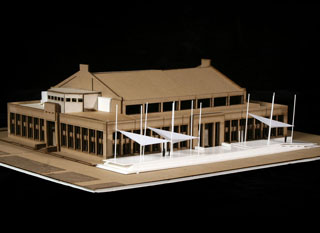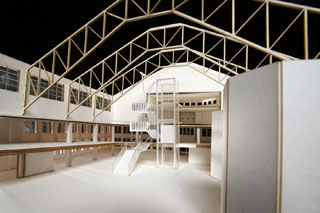|
Subscribe / Renew |
|
|
Contact Us |
|
| ► Subscribe to our Free Weekly Newsletter | |
| home | Welcome, sign in or click here to subscribe. | login |
Real Estate
| |
October 19, 2009
New $60M home for MOHAI: City may OK the deal today
Journal Staff Reporter
The Seattle City Council is ready to approve an agreement that will pave the way for the Museum of History and Industry to move to the Naval Reserve Armory at Lake Union Park.
The deal, which has been years in the making, will be followed by a $45 million construction project that MOHAI officials expect to start in early 2011.
Sellen Construction is the general contractor. The company plans to start seeking sub-contractors in the fourth quarter of 2010.
The council is expected to approve the deal with MOHAI today.
“It's going to pass,” said Ann Corbitt, aide to Councilman Tom Rasmussen, who chairs the parks committee that has been overseeing the process. “It works out well for everybody.”
Built in the early 1940s, the armory is an example of pre-war art deco and moderne styles of architecture, and is a national and city landmark.
“It is, in many ways, the perfect venue for MOHAI,” said Leonard Garfield, executive director of the museum. MOHAI today is tucked away in a park just north of state Route 520. Garfield said the armory itself is an artifact, and its high-profile location is another plus: in the new park and next to other cultural amenities, such as the Center for Wooden Boats and the Virginia V steamship.
Converting a landmark
The blue and white concrete armory is where thousands of Navy recruits were trained from World War II through the Gulf War, according to Garfield.
On the north side of the nearly 52,700-square-foot building are two spaces that resemble parts of a ship. One is a chart room. Above it is the bridge of the faux ship.
“When you stand here you feel like you are piloting [the armory] across Lake Union,” said Sam Miller, a principal at LMN Architects, which has been working on the conversion for two years.
In 1998, the Navy decommissioned the armory and transferred the property to the city. Today it's used as office space for nonprofits as well as for community meetings and events.
But the armory wasn't designed as a museum. Renovation will require adding significant mechanical systems and other environmental controls to protect artifacts while maintaining the historic character of the structure.
“There's a real fine balance,” Miller said. To make the equipment as unobtrusive as possible, Miller and John Nesholm, an LMN founding partner, are creating a well space on the lower roof of the armory.
MOHAI also cannot drastically alter the exterior. The one major change is adding a large terrace on the west side. It will have large canopies with banner poles to mark the entrance.
Dramatic interior
Miller calls the interior “a two-story doughnut.” When the drop ceiling is removed, a double-height ceiling with trusses will be exposed. Those trusses will serve two purposes. Artifacts, such as airplanes and hydroplanes, will dangle from the beams.
The other use is structural. The armory, which the city seismically upgraded four years ago, was built on pilings over water. LMN is designing a large stairway and elevator to improve access and will hang those elements from the trusses to spread the weight.
The armory is about the same size as MOHAI's museum, but the openness of the space is much more conducive to a museum, according to Garfield. It will provide 50 percent more room for exhibits.
“This will be a very different MOHAI,” Nesholm said.
Exhibits will be encapsulated in octaganal tubes called “vertical galleries.” Twenty-four feet across, these galleries will rise from the main floor of the gallery to the atrium. The goal is to maintain the sense of openness in the main exhibition space.
A 5,000-square-foot gallery on the second level will be for traveling exhibits from the Smithsonian and other groups. On the third and fourth levels, which are where the chart room and bridge replicas were housed, MOHAI will work with “heritage partners” from across the region on exhibits. The fourth floor will be dedicated to Seattle's maritime history.
Ann Farrington, MOHAI's creative director, is leading design of the exhibit space. She is working with a team of designers, including Weatherhead Experience Design Group and Pacific Studio, both of Seattle, as well as sound and lighting designers.
The overall cost of the project will be $60 million. MOHAI is in the midst of a $40 million private fund-raising campaign. To date, $17 million has been raised, and Garfield said the group is optimistic that it will reach its goal.
MOHAI is going to use historic tax credits to help fund improvements, and will receive some money from the state for relocating to make way for the new Highway 520, though Garfield said the amount has not been determined yet.
Seneca Real Estate Group is helping MOHAI put together a deal with the city. It calls for the museum to take ownership of the building and sign a 55-year ground lease on the site. In exchange, the museum agrees to provide public services and benefits, such as working with other heritage organizations.
Another benefit is that youth ages 14 and younger will be admitted to the museum for free. That's a big change for MOHAI and is “one of the things we are very proud (of),” Garfield said. “Young people really need to explore history to make good decisions for today and tomorrow.”
The new MOHAI is scheduled to open in the fall of 2012.




